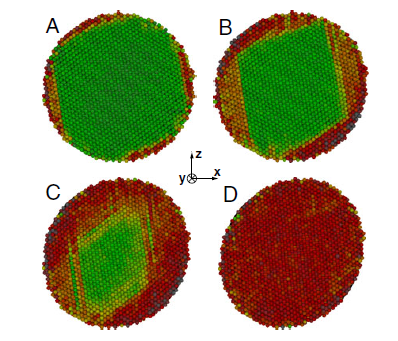Physicists from the University of Constance, Peter Nielaba and Daniel Mutter, have observed some changes in shape memory materials at the nanometric scale. These observations have been published as an article in the European Physical Journal B.
 Visualization of a transforming nanoparticle with diameter d=10 nm. The xz-plane through the origin is shown at temperatures (A) 239 K, (B) 259 K, (C) 275 K, and (D) 289 K.
Visualization of a transforming nanoparticle with diameter d=10 nm. The xz-plane through the origin is shown at temperatures (A) 239 K, (B) 259 K, (C) 275 K, and (D) 289 K.
It is possible to compress or stretch metal alloys in such a manner so as to make them retain their deformity even after the strain on the material is released. However, alloys known as ‘shape memory alloys’ can remember and go back to their actual shape, if they are heated above a certain temperature.
The physicists measured the absolute temperature values at which these shape memory alloys or nanospheres begin returning back to their original shape stored in their memory. The nanospheres undergo a phenomenon called structural phase transition, which is dependent on the size of the particles being analyzed. The researchers carried out a computer simulation with the help of nanoparticles of diameter ranging from 4 to 17 nm. The nanoparticles consisted of equal amounts of titanium and nickel.
A computerised process called molecular dynamics simulation was used by the physicists to visualise how the material transformed at the time of the transition. They were able to prove that with the increase in temperature the atomic-scale crystal structure of the material transformed from a low symmetry to a higher symmetry level. They observed that the difference in energy between the structures with low- and high symmetries at the nanoparticle surface strongly influenced the transition. Also, the symmetry levels at the surface were different from that in the interior of the nanoparticle.
Shape memory alloys were studied so far at the macroscopic scale and their applications were limited to stents, dental braces or oil temperature-regulating equipments for use in bullet trains. In light of this atomic-scale research, potential applications of these shape-memory materials could be nanoswitch creation, where laser irradiation can be used to heat the alloy, thus causing a change in length, which in turn could work as a switch.